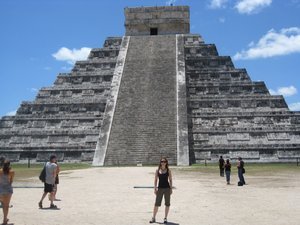Advertisement

 Castillo
Castillo
The main attractionChichen Itza
Getting there
We paid for a transportation package thinking that the entrance fee was also included to Chichen Itza, but upon arrival, we discovered that it was not.... lesson: always read the fine print!
At the entrance, there were many vendors selling hats and we soon learnt why, because the heat at the grounds was exceptionally hot to the point of unbearable for some. We joined an American group for an English tour and an elderly lady in their group had to sit down under a tree and miss the tour due to the searing sun. Due to the Swine Flu, the number of tourists travelling to Mexico has dropped dramatically and we were told that normally there would be about 4000 people at the site normally at this time of year, but at the moment, they were only getting 400 people visiting. Not good for their industry, but good for us in that there were less people around when viewing the old buildings.
Fascinating architecture and sculpture
The buildings are the reason to visit Chichen Itza. The architecture and scuplture inlaid into the walls are different to anything that we have seen so

 Snake staircase
Snake staircase
There is an illusion of the snake during the equinox.far in our travels. Most of the colour has gone from the walls, but you can still clearly see pictures of jaguars, snakes and ceremonially dressed people. The Castillo or main temple is the main attraction. It looks like a pyramid, but was not used for the burial of kings, like the Egyptian pyramids. It was used for religious purposes and also as a calendar. The occupants, who were the Toltec-Mayan people, knew a lot about astronomy. They recorded the annual cycle of the sun as 365 days and also the lunar cycle. They had tables for the solar eclipses that would occur in a period of 33 years and understood the cycles of Mars, Jupiter and Saturn. With this knowledge, they created 2 calendars, one for the 365 day solar cycle and one that was used to determine the festivals of the gods and predict human destinies.
In the parts that have been excavated so far, we saw high platforms, sloping walls, staircases with serpent heads at the bottom, alters and skull decorations. One square wall complex was covered in skull sculptures and we were told that heads of people were stuck on poles within the walls, so
that they were high enough to be visible as a warning for all to be good. Only those who were bad had their head on display. All the information that we were told were all theories of the archeologists who continue to work there.
Sacrifice
A sacred cenote (a hole with water in it that comes from an underground river) is close to the main part of the grounds. We were told that many offerings, like silver and jewels, went into the water, but also humans were also sacrified to the mean god of the cenote to appease him. The people thought the hole was also an entrance into the underworld of death. It is not known whether only bad people were sacrificed or chosen people from the community sacrificed themselves. Other sacrifices occurred in the community. People were sacrificed on alters, where the chest was opened and the heart was ripped out and offered to the rain god. Sacrifice did not always end in death. The people that lived also sacrificed by hurting themselves, like grinding their teeth down into pointing tips. Sounds like a painful culture to me...
A game of ball
A large
ball court also exists not far from the Castillo. Children who were born at a special time of the year were selected to train for this sport all of their lives. A solid rubber ball was passed around from the hip or shoulder of each of the players, as head, legs and arms were not allowed to be used. There are 2 stone hoops built into the inward slopping walls that create the sides of the court, where the ball had to pass for the team to gain immediate victory. The height of the hoop and the small size of the hole in the hoop make it seem near impossible for a ball to be passed through. Two teams played at any one time, however they did not play against each other. They played their own game with the winner being the team who scores first. The game was a spiritual one and so it was not meant to be easy, but the players were well skilled as they had been practising all their lives. The ball represented the movement of the stars in the sky and the teams symbolised the struggle between day and night or between the gods
of the underworld and those of the sky. On the wall of the ball court there are scultures of the teams in their elaborate team dress. One of the team members has no head and the priest is holding his head. One theory is that the captain of the winning team has the honour of being executed in sacrifice to the gods and others say that it is the fate of the captain of the losing team or even prisoners of war.
Hard life
Back at the hostel, we cooled down by relaxing with a couple of Coronas, chilling out in the courtyard with Dan enjoying the cooling air of swinging in the hotel's hammock.
Advertisement
Tot: 0.132s; Tpl: 0.015s; cc: 15; qc: 62; dbt: 0.0625s; 1; m:domysql w:travelblog (10.17.0.13); sld: 1;
; mem: 1.2mb















